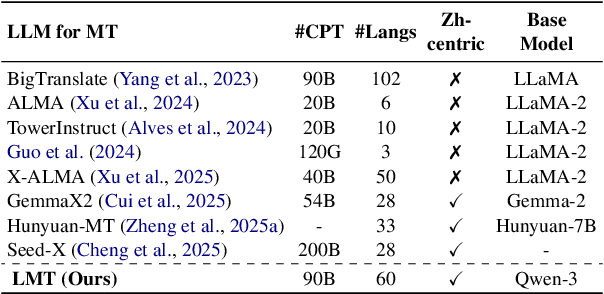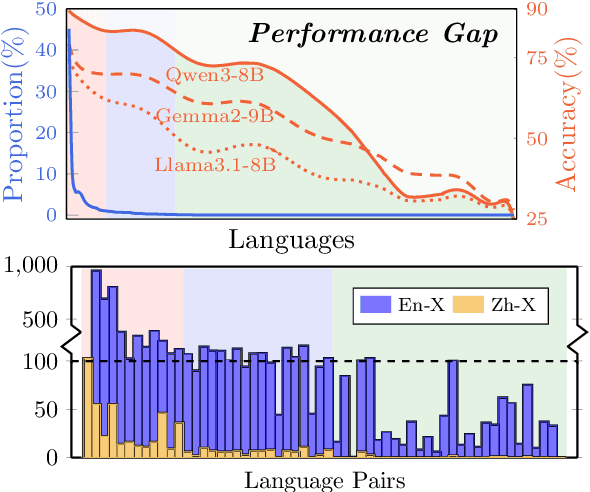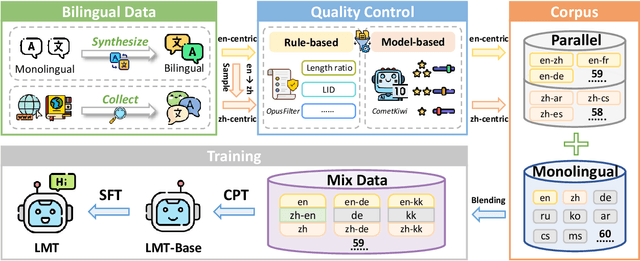Tong Xiao
Jack
REFA: Real-time Egocentric Facial Animations for Virtual Reality
Jan 07, 2026Abstract:We present a novel system for real-time tracking of facial expressions using egocentric views captured from a set of infrared cameras embedded in a virtual reality (VR) headset. Our technology facilitates any user to accurately drive the facial expressions of virtual characters in a non-intrusive manner and without the need of a lengthy calibration step. At the core of our system is a distillation based approach to train a machine learning model on heterogeneous data and labels coming form multiple sources, \eg synthetic and real images. As part of our dataset, we collected 18k diverse subjects using a lightweight capture setup consisting of a mobile phone and a custom VR headset with extra cameras. To process this data, we developed a robust differentiable rendering pipeline enabling us to automatically extract facial expression labels. Our system opens up new avenues for communication and expression in virtual environments, with applications in video conferencing, gaming, entertainment, and remote collaboration.
Probing Preference Representations: A Multi-Dimensional Evaluation and Analysis Method for Reward Models
Nov 16, 2025Abstract:Previous methods evaluate reward models by testing them on a fixed pairwise ranking test set, but they typically do not provide performance information on each preference dimension. In this work, we address the evaluation challenge of reward models by probing preference representations. To confirm the effectiveness of this evaluation method, we construct a Multi-dimensional Reward Model Benchmark (MRMBench), a collection of six probing tasks for different preference dimensions. We design it to favor and encourage reward models that better capture preferences across different dimensions. Furthermore, we introduce an analysis method, inference-time probing, which identifies the dimensions used during the reward prediction and enhances its interpretability. Through extensive experiments, we find that MRMBench strongly correlates with the alignment performance of large language models (LLMs), making it a reliable reference for developing advanced reward models. Our analysis of MRMBench evaluation results reveals that reward models often struggle to capture preferences across multiple dimensions, highlighting the potential of multi-objective optimization in reward modeling. Additionally, our findings show that the proposed inference-time probing method offers a reliable metric for assessing the confidence of reward predictions, which ultimately improves the alignment of LLMs.
Beyond English: Toward Inclusive and Scalable Multilingual Machine Translation with LLMs
Nov 10, 2025



Abstract:Large language models have significantly advanced Multilingual Machine Translation (MMT), yet the broad language coverage, consistent translation quality, and English-centric bias remain open challenges. To address these challenges, we introduce \textbf{LMT}, a suite of \textbf{L}arge-scale \textbf{M}ultilingual \textbf{T}ranslation models centered on both Chinese and English, covering 60 languages and 234 translation directions. During development, we identify a previously overlooked phenomenon of \textbf{directional degeneration}, where symmetric multi-way fine-tuning data overemphasize reverse directions (X $\to$ En/Zh), leading to excessive many-to-one mappings and degraded translation quality. We propose \textbf{Strategic Downsampling}, a simple yet effective method to mitigate this degeneration. In addition, we design \textbf{Parallel Multilingual Prompting (PMP)}, which leverages typologically related auxiliary languages to enhance cross-lingual transfer. Through rigorous data curation and refined adaptation strategies, LMT achieves SOTA performance among models of comparable language coverage, with our 4B model (LMT-60-4B) surpassing the much larger Aya-101-13B and NLLB-54B models by a substantial margin. We release LMT in four sizes (0.6B/1.7B/4B/8B) to catalyze future research and provide strong baselines for inclusive, scalable, and high-quality MMT \footnote{\href{https://github.com/NiuTrans/LMT}{https://github.com/NiuTrans/LMT}}.
TimeSense:Making Large Language Models Proficient in Time-Series Analysis
Nov 09, 2025Abstract:In the time-series domain, an increasing number of works combine text with temporal data to leverage the reasoning capabilities of large language models (LLMs) for various downstream time-series understanding tasks. This enables a single model to flexibly perform tasks that previously required specialized models for each domain. However, these methods typically rely on text labels for supervision during training, biasing the model toward textual cues while potentially neglecting the full temporal features. Such a bias can lead to outputs that contradict the underlying time-series context. To address this issue, we construct the EvalTS benchmark, comprising 10 tasks across three difficulty levels, from fundamental temporal pattern recognition to complex real-world reasoning, to evaluate models under more challenging and realistic scenarios. We also propose TimeSense, a multimodal framework that makes LLMs proficient in time-series analysis by balancing textual reasoning with a preserved temporal sense. TimeSense incorporates a Temporal Sense module that reconstructs the input time-series within the model's context, ensuring that textual reasoning is grounded in the time-series dynamics. Moreover, to enhance spatial understanding of time-series data, we explicitly incorporate coordinate-based positional embeddings, which provide each time point with spatial context and enable the model to capture structural dependencies more effectively. Experimental results demonstrate that TimeSense achieves state-of-the-art performance across multiple tasks, and it particularly outperforms existing methods on complex multi-dimensional time-series reasoning tasks.
MRO: Enhancing Reasoning in Diffusion Language Models via Multi-Reward Optimization
Oct 24, 2025



Abstract:Recent advances in diffusion language models (DLMs) have presented a promising alternative to traditional autoregressive large language models (LLMs). However, DLMs still lag behind LLMs in reasoning performance, especially as the number of denoising steps decreases. Our analysis reveals that this shortcoming arises primarily from the independent generation of masked tokens across denoising steps, which fails to capture the token correlation. In this paper, we define two types of token correlation: intra-sequence correlation and inter-sequence correlation, and demonstrate that enhancing these correlations improves reasoning performance. To this end, we propose a Multi-Reward Optimization (MRO) approach, which encourages DLMs to consider the token correlation during the denoising process. More specifically, our MRO approach leverages test-time scaling, reject sampling, and reinforcement learning to directly optimize the token correlation with multiple elaborate rewards. Additionally, we introduce group step and importance sampling strategies to mitigate reward variance and enhance sampling efficiency. Through extensive experiments, we demonstrate that MRO not only improves reasoning performance but also achieves significant sampling speedups while maintaining high performance on reasoning benchmarks.
SUBQRAG: sub-question driven dynamic graph rag
Oct 09, 2025Abstract:Graph Retrieval-Augmented Generation (Graph RAG) effectively builds a knowledge graph (KG) to connect disparate facts across a large document corpus. However, this broad-view approach often lacks the deep structured reasoning needed for complex multi-hop question answering (QA), leading to incomplete evidence and error accumulation. To address these limitations, we propose SubQRAG, a sub-question-driven framework that enhances reasoning depth. SubQRAG decomposes a complex question into an ordered chain of verifiable sub-questions. For each sub-question, it retrieves relevant triples from the graph. When the existing graph is insufficient, the system dynamically expands it by extracting new triples from source documents in real time. All triples used in the reasoning process are aggregated into a "graph memory," forming a structured and traceable evidence path for final answer generation. Experiments on three multi-hop QA benchmarks demonstrate that SubQRAG achieves consistent and significant improvements, especially in Exact Match scores.
FLEXI: Benchmarking Full-duplex Human-LLM Speech Interaction
Sep 26, 2025Abstract:Full-Duplex Speech-to-Speech Large Language Models (LLMs) are foundational to natural human-computer interaction, enabling real-time spoken dialogue systems. However, benchmarking and modeling these models remains a fundamental challenge. We introduce FLEXI, the first benchmark for full-duplex LLM-human spoken interaction that explicitly incorporates model interruption in emergency scenarios. FLEXI systematically evaluates the latency, quality, and conversational effectiveness of real-time dialogue through six diverse human-LLM interaction scenarios, revealing significant gaps between open source and commercial models in emergency awareness, turn terminating, and interaction latency. Finally, we suggest that next token-pair prediction offers a promising path toward achieving truly seamless and human-like full-duplex interaction.
SageLM: A Multi-aspect and Explainable Large Language Model for Speech Judgement
Aug 28, 2025Abstract:Speech-to-Speech (S2S) Large Language Models (LLMs) are foundational to natural human-computer interaction, enabling end-to-end spoken dialogue systems. However, evaluating these models remains a fundamental challenge. We propose \texttt{SageLM}, an end-to-end, multi-aspect, and explainable speech LLM for comprehensive S2S LLMs evaluation. First, unlike cascaded approaches that disregard acoustic features, SageLM jointly assesses both semantic and acoustic dimensions. Second, it leverages rationale-based supervision to enhance explainability and guide model learning, achieving superior alignment with evaluation outcomes compared to rule-based reinforcement learning methods. Third, we introduce \textit{SpeechFeedback}, a synthetic preference dataset, and employ a two-stage training paradigm to mitigate the scarcity of speech preference data. Trained on both semantic and acoustic dimensions, SageLM achieves an 82.79\% agreement rate with human evaluators, outperforming cascaded and SLM-based baselines by at least 7.42\% and 26.20\%, respectively.
HEAL: A Hypothesis-Based Preference-Aware Analysis Framework
Aug 27, 2025



Abstract:Preference optimization methods like DPO have achieved remarkable performance in LLM alignment. However, the evaluation for these methods relies on a single response and overlooks other potential outputs, which could also be generated in real-world applications within this hypothetical space. To address this issue, this paper presents a \textbf{H}ypothesis-based Pr\textbf{E}ference-aware \textbf{A}na\textbf{L}ysis Framework (HEAL), a novel evaluation paradigm that formulates preference alignment as a re-ranking process within hypothesis spaces. The framework incorporates two complementary metrics: ranking accuracy for evaluating ordinal consistency and preference strength correlation for assessing continuous alignment. To facilitate this framework, we develop UniHypoBench, a unified hypothesis benchmark constructed from diverse instruction-response pairs. Through extensive experiments based on HEAL, with a particular focus on the intrinsic mechanisms of preference learning, we demonstrate that current preference learning methods can effectively capture preferences provided by proxy models while simultaneously suppressing negative samples. These findings contribute to preference learning research through two significant avenues. Theoretically, we introduce hypothesis space analysis as an innovative paradigm for understanding preference alignment. Practically, HEAL offers researchers robust diagnostic tools for refining preference optimization methods, while our empirical results identify promising directions for developing more advanced alignment algorithms capable of comprehensive preference capture.
LaTeXTrans: Structured LaTeX Translation with Multi-Agent Coordination
Aug 26, 2025Abstract:Despite the remarkable progress of modern machine translation (MT) systems on general-domain texts, translating structured LaTeX-formatted documents remains a significant challenge. These documents typically interleave natural language with domain-specific syntax, such as mathematical equations, tables, figures, and cross-references, all of which must be accurately preserved to maintain semantic integrity and compilability. In this paper, we introduce LaTeXTrans, a collaborative multi-agent system designed to address this challenge. LaTeXTrans ensures format preservation, structural fidelity, and terminology consistency through six specialized agents: 1) a Parser that decomposes LaTeX into translation-friendly units via placeholder substitution and syntax filtering; 2) a Translator, Validator, Summarizer, and Terminology Extractor that work collaboratively to ensure context-aware, self-correcting, and terminology-consistent translations; 3) a Generator that reconstructs the translated content into well-structured LaTeX documents. Experimental results demonstrate that LaTeXTrans can outperform mainstream MT systems in both translation accuracy and structural fidelity, offering an effective and practical solution for translating LaTeX-formatted documents.
 Add to Chrome
Add to Chrome Add to Firefox
Add to Firefox Add to Edge
Add to Edge